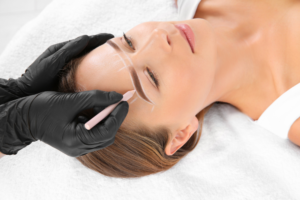Hair loss is a common concern for men, affecting millions globally. While hair loss can have various causes, male pattern baldness, also known as androgenetic alopecia, is the most prevalent culprit. Understanding this condition is the first step towards addressing it and exploring potential solutions.

Unveiling the Cause: Genetics and Hormones Play a Role
Male pattern baldness is primarily caused by a combination of genetics and hormones. Here’s a breakdown of the key factors:
- Genetics: If male pattern baldness runs in your family, you’re more likely to experience it. Genes determine your sensitivity to a hormone called dihydrotestosterone (DHT), which shrinks hair follicles and shortens their growth cycle.
- Androgenetic Alopecia: DHT weakens hair follicles over time, leading to progressively shorter and finer hair growth. Eventually, hair follicles may stop producing hair altogether.

Recognizing the Signs: A Guide to Male Pattern Baldness
Male pattern baldness typically follows a predictable pattern:
- Receding Hairline: Hair begins to recede at the temples, forming an “M” shape on the forehead.
- Thinning Hair on the Crown: Hair loss progresses on the top of the head, often starting at the crown and gradually expanding.
- Horseshoe Pattern: Over time, the receding hairline and thinning crown may connect, forming a horseshoe-shaped pattern of remaining hair.

Addressing Hair Loss: Exploring Treatment Options
While there’s no permanent cure for male pattern baldness, effective treatment options are available:
- Medications: Minoxidil and finasteride are FDA-approved medications that can slow down hair loss and promote some hair regrowth.
- Hair Transplant Surgery: This surgical procedure involves transplanting healthy hair follicles from a donor area to the balding scalp.
- Low Level Laser Therapy (LLLT): This non-invasive treatment uses low-level laser light to stimulate hair growth.

Proactive Measures: Can Hair Loss Be Prevented?
While there’s no guaranteed way to prevent hair loss entirely, some proactive measures might be helpful:
- Maintain a Healthy Lifestyle: A balanced diet, regular exercise, and adequate sleep contribute to overall health and may indirectly support hair growth.
- Manage Stress: Chronic stress can contribute to hair loss. Techniques like meditation or yoga can help manage stress levels.
- Scalp Care: Maintaining a clean scalp and using gentle hair care products can promote a healthy scalp environment for hair growth

Conclusion: Taking Control of Hair Loss at Ziva Wellness
Hair loss can be a source of concern, but it doesn’t have to define you. With the right knowledge and potential treatment options, you can take control of your hair loss journey.
Ready to explore solutions for male pattern baldness?
Contact Ziva Wellness today!
Our team of experienced professionals can assess your individual situation and recommend the best course of action for achieving your hair restoration goals. We offer a variety of hair loss treatment options and are committed to helping you regain your confidence and achieve a fuller head of hair.




